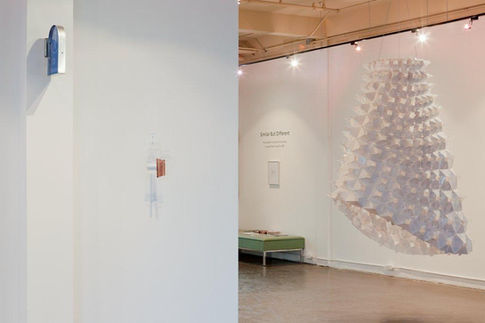SIMILAR BUT DIFFERENT
Curated by: Jayda Karsten
The New Gallery, Calgary, AB (2013)
Artists/ Architects: Sol Aasland, Elmira Aghsaei, Asmaa Al-Issa, Roverto Cioffi, Will Frank, Jillian Gerlach, Alyssa Haas, Linds Horan, Alana Piche, Neal Philipsen, Andrew Pun, Jason McMullen, Kurtis Nishiyara, Stephen Rowe, Donny Wolcottm, and Marc Boutin.

Curatorial Statement:
I sense a return to the collaborative approach of art, architecture, and design with the inclusion of other disciplines such as math, science, psychology, and technology. Throughout history there has been much debate over the connectivity or individuality of disciplines. Through this curatorial process I was able to see the convergences and departures of both Environmental Design Studies (EVDS) and Fine Art students at the University of Calgary. These up-and-coming artists and architects have created works that bridge their specific disciplines and opened a conversation on shared language, methodologies, processes and intentions. I would like to thank The New Gallery, who approached this project with the intent to provide a bridge between the Alberta College of Art + Design (ACAD) and the University of Calgary (UofC) through an inter-institutional exhibition.
Historically, during the Renaissance period in particular, artists such as Bernini and Michelangelo referred tot themselves as architects as well as sculptors and painters. In late Victorian Britain this division was questioned by William Morris and John Ruskin through the Arts and Crafts Movement. The early twentieth century saw groups such as Bauhaus and De Stijl advocating an increased dialogue between art, architecture, design, and technology. The quest for the Gesamtkunstwerk ("total art work") popularized in the late 20th century, describes circumstances where the architect oversees the entire building's design including: the shell, interior accessories, furnishings and landscape [rev.1]. Fast-forward into the present day where the zeitgeist of Calgary's artists, architects, and designers continues to be one of interdisciplinary exploration.
One observation is how technology is more than just a tool but also a medium for those in creative disciplines. Stephen Rowe and Linds Horan both turned to technology and the virtual world for the language used to communicate their site-specific guerrilla installations. This is a surprising twist on how objects are typically appropriated through remediation, taking something from the physical world and reinterpreting it in the virtual world, has been completely reversed. Similarly, Alyssa Haas' design for a Cellphone Booth was created entirely in a virtual environment that is both weightless without human scale and then brought into reality. This complex structure has both an architectural and artistic feeling to it; combined with a design intention for function in a process she describes as "digital sculpting".
Another observation was how concerned artists and architects are with social, physical, and mental well-being. Asmaa Al-Issa's Surface is a site specific installation inspired by eastern philosophies and through "ritualistic and meditative" processes. The result is a labyrinthine reflective space within the gallery, while Elmira Aghsaei, Will Frank, and Jason McMullen's installations try to alleviate social awkwardness in the public realm and encourage playfulness in parks, LRT stations to increase public well-being. In contrast, it is often the well-being of the lower class in society that is a predictably low priority. Sol Aasland, Andrew Pun, and Alana Piche seek to draw our attention to the social injustices that are prevalent in our city and how the social, physical, and mental wellness of the homeless goes undiagnosed.
These are just some examples of the many interconnections that artists, architects, and designers share; creating outcomes that are Similar But Different. Having arrived at this point, I have to ask myself how the distinctions of disciplines is either helpful or harmful in terms of generating dialogue around larger social, political and environmental issues - and is the term "interdisciplinary" becoming a cliche?
-Jayda Karsten, 2013
[rev. 1 - July, 2020]













